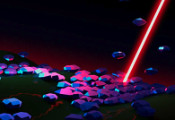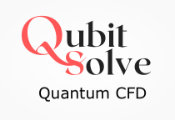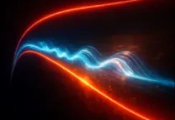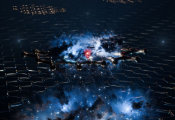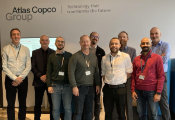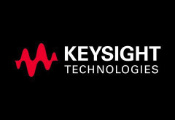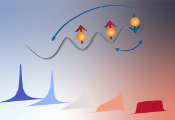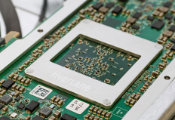Research Reveals Quantum Entanglement Among Quarks
January 29, 2024 -- Time evolution of the quark-antiquark pair produced by high-energy particle collisions. The pair separates in space, producing additional quark-antiquark pairs, but it still maintains the quantum entanglement.
Collisions of high energy particles produce "jets" of quarks, anti-quarks, or gluons. Due to the phenomenon called confinement, scientists cannot directly detect quarks. Instead, the quarks from these collisions fragment into many secondary particles that can be detected.
Scientists recently addressed jet production using quantum simulations. They found that the propagating jets strongly modify the quantum vacuum—the quantum state with the lowest possible energy. In addition, the produced quarks retain quantum entanglement, the linkage between particles across distances. This finding, published in Physical Review Letters, means that scientists can now study this entanglement in experiments.
This research performed quantum simulations that have detected the modification of the vacuum by the propagating jets. The simulations have also revealed quantum entanglement among the jets. This entanglement can be detected in nuclear experiments. The work is also a step forward in quantum-inspired classical computing. It may result in the creation of new application-specific integrated circuits.
Collisions of high energy particles produce "jets"—quarks, antiquarks, or gluons moving through the quantum vacuum. Due to the confinement property of strong interactions, quarks are never directly detected but instead fragment into many secondary particles.
Scientists have long expected that as jets propagate through the confining quantum vacuum, they will modify that vacuum. Scientists have also proposed that the initial quark-antiquark pair may retain quantum entanglement, at least for some time. However, these problems could not be solved previously due to lack of appropriate theoretical and computational tools.
That situation has changed with the advent of quantum computing methods.
These long-standing problems in nuclear physics have been addressed by a team of scientists from Stony Brook University and Brookhaven National Laboratory that is collaborating with computing company NVIDIA. Their results can stimulate experimental work on detecting entanglement at Brookhaven National Lab and elsewhere.

